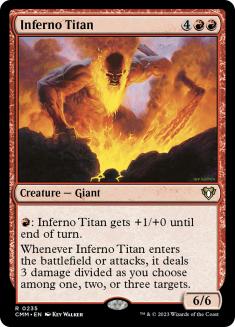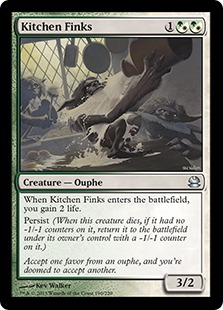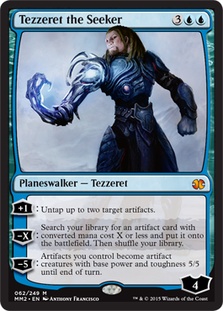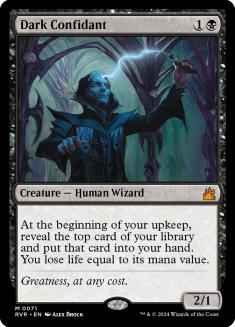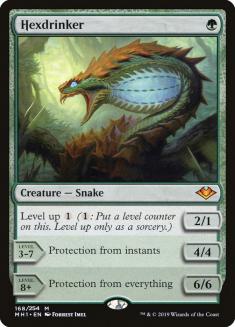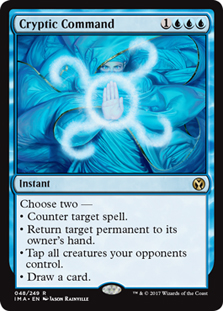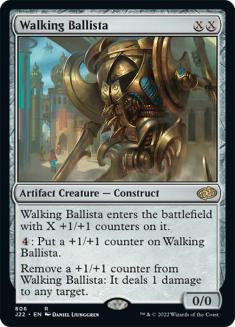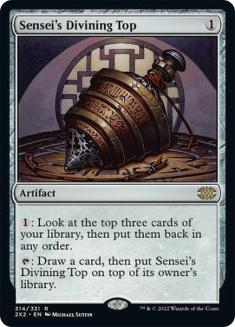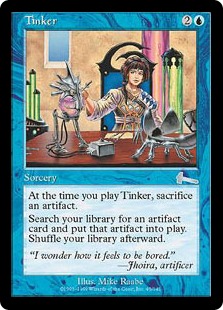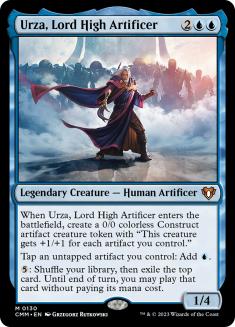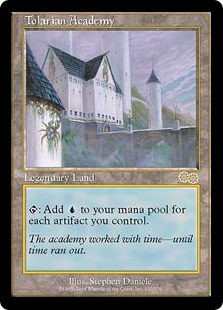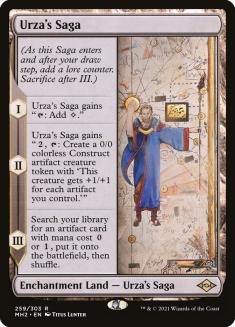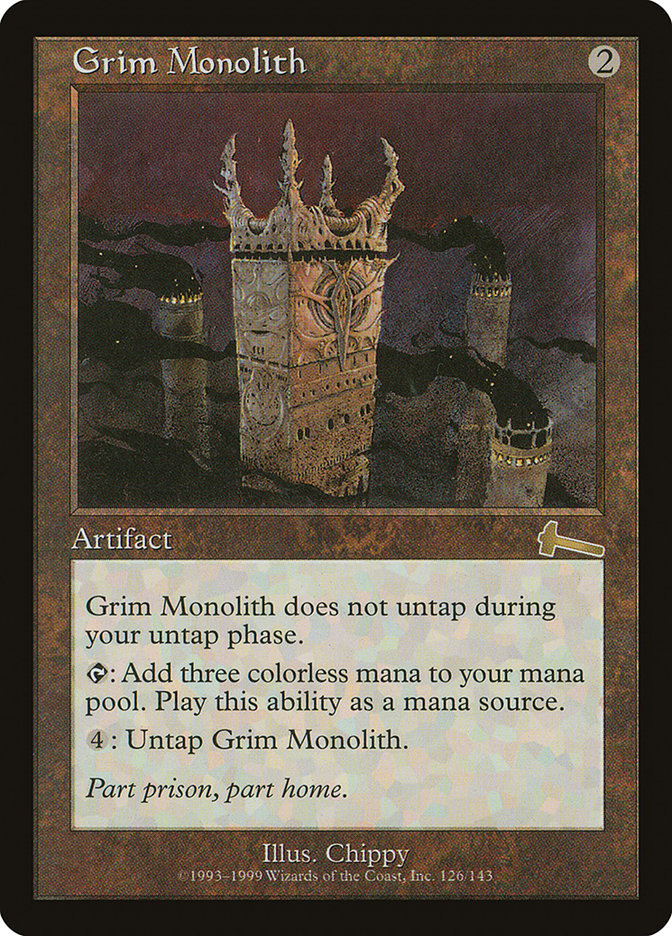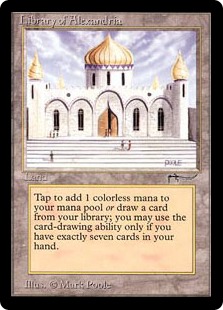The solstice has come and gone, but even as we start to lose daylight, our love of Cube Draft endures. We still have another week of Vintage Cube on Magic Online (MTGO) and I have unfinished business on that matter. Last week, I went over what I believe to be the ten most overrated cards in the MTGO Vintage Cube. This week, it’s only fitting that I go over what I believe the ten most underrated cards in the Cube.
Similarly to last week, there’s a range in power levels here and a range in how late that these cards should be picked in the average draft. The common thread is that I see all of these cards consistently go late enough that they’re very easy picks when they get to me. For some of these cards that means that I wheel them because I know that I can get away with it. Others should almost never be passed but often are. My write-up on each card should make clear which category that card falls into. Let’s get on with it, then!
10. Inferno Titan
Some of today’s list exists as a foil to last week’s. I see Splinter Twin as overrated because win conditions in Izzet decks are largely interchangeable, but Splinter Twin still gets drafted very highly. Inferno Titan, or ol’ reliable as I like to call it, usually goes pretty late and is still an absolute beating over ten years after its original printing.
Inferno Titan doesn’t fit into aggressive red decks at all and isn’t a great Reanimator target, so it makes sense that the card goes as late as it does, but it’s great in Izzet decks, as I’ve said, as well as any deck looking to leverage a Sneak Attack by virtue of being both relatively powerful against a lot of decks and more castable than other creatures that you’d want to Sneak in. The Titan can add a lot of consistency to strategies intent on cheating creatures onto the battlefield that otherwise have decent access to red mana, largely because Inferno Titan is an absolute house against aggressive decks while having very fast closing speed everywhere else.
I felt pretty similarly about Frost Titan when it was in the Cube, and while you don’t want many six-mana spells in your Vintage Cube decks, I do find that having one or two goes a long way in any situation where you find yourself playing a drawn-out game. We like to think about Vintage Cube as this totally broken landscape where everybody is trying to win as quickly as possible, but the more interactive either deck is, the longer the average game will be, and the more value you’ll derive from having a couple of castable hammers in your deck.
I’m not saying to first-pick Inferno Titan. Realistically, taking Inferno Titan fourth is going to be too early out of a lot of packs. I consider the card underrated because it feels like I can always get Inferno Titan when I want it, and I want it pretty often. Maybe you shouldn’t take Inferno Titan fourth all that often, but I probably shouldn’t be able to get it tenth.
9. Kitchen Finks
I basically never want a Savannah in my Vintage Cube decks, so I totally understand valuing Selesnya cards very low. Kitchen Finks’s greatest strength is perhaps in its hybrid mana cost, though it’s also true that mono-white and mono-green decks don’t want to maindeck the card, albeit for different reasons. Aggressive white decks have much better threats for three mana, and green decks tend to ramp well past the need for a Kitchen Finks. So why am I so high on the card?
Because decks that aren’t strictly aggressive or heavy on mana acceleration tend to be very interested in a creature that’s good at both blocking and attacking planeswalkers. I maindeck Kitchen Finks far more often than not in my Azorius Control and Sultai Midrage decks, given how good it is in any sort of attrition battle. Control decks don’t love playing many creatures, but the rate on this one is just good, and the persist mechanic means that, as long as the game is about combat at all for any reason, you’re likely to get at least one thing that you want out of the Finks.
Kitchen Finks isn’t broken or anywhere near the power level of the best cards in the Cube, but it is a major benefactor in a shift that we’ve seen over time in Cube. As cheap creatures and planeswalkers get better and better, the games where a Kitchen Finks matters become more and more common. Like Inferno Titan I’m not advocating for drafting Kitchen Finks super-early, but I am advocating for scooping it up sometime around eighth and maindecking the card more often than what I tend to see.
8. Tezzeret the Seeker
Here’s the first busted card on my list. Five mana isn’t cheap, and Tezzeret is a little specific, but the stuff Tezzeret cares about is all incredibly good, and I try to have a good clip of artifacts in most of my blue Vintage Cube decks anyway. Tezzeret allows you to establish mana advantages, tutor for some very powerful cards, and is a win condition in decks that have a decent clip of artifacts. When the deck is open, I consider Mono-Blue busted stuff to be the most powerful deck in the Cube, and every time I find myself in that archetype, Tezzeret carries its weight very well.
Using Tezzeret to untap mana rocks is the obvious baseline for the card, but I also find most players underuse the toolbox that Tezzeret opens up. Whether you’re hedging with your Tezzeret to grab a Coalition Relic, cashing it in to grab Coercive Portal, or locking your opponent out with Tangle Wire, Tezzeret does several very powerful things. Jim Davis might say that Tangle Wire is the underrated card here, though for me Tezzeret is the real hero.
I find that I’m able to wheel Tezzeret an outrageous amount of the time by virtue of the card being somewhat specific, but the card is so powerful where it’s good that I still make the safe play and draft Tezzeret somewhere around fourth pick to make sure that I have access to it.
7. Dark Confidant
If you’re not willing to put Dark Confidant in the same deck as Griselbrand, then I’m not convinced that you’re interested in greatness. Any. Cost. Gamers.
I mostly only see Dark Confidant out of opposing aggressive decks, Orzhov piles that take the already powerful Mono-White Aggro shell and scoop up Scrubland to splash for Lingering Souls and a couple of other cards. These decks can be solid, but I don’t see nearly enough Dark Confidants out of opposing Dimir decks!
Dark Confidant is great in Reanimator, Storm, and honestly most Dimir/X Midrange decks. I love Dark Confidant in Sultai. The power level of Vintage Cube is so high that you’ll rarely have time to lose to your own Dark Confidant. Even when your opponent is pressuring your life total, you’ll often have the option to trade Dark Confidant away or at least chump block if you want to take the coward’s route.
Dark Confidant is another card that should probably go around fourth or fifth on average, but that I see near the end of the pack very often. If we’re so risk-averse, why are we playing Vintage Cube in the first place?
6. Hexdrinker
There’s really not a green archetype in Vintage Cube that wouldn’t start Hexdrinker. I suppose if you’re playing Oath of Druids, then you shouldn’t be playing one-mana creatures, but the issues with playing Oath of Druids far exceed any issues associated with playing Hexdrinker.
Plenty of players have picked up on the fact that Hexdrinker is among the more impactful green cards in the Cube, but I still see it going quite late in the average draft. If you’re among the players unconvinced, a lot of the card’s strength comes in the low opportunity cost of a scaleable one-mana threat. It’s not just that Hexdrinker becomes a Progenitus; it’s that trading early against aggressive decks or even getting up to the 4/4 makes the card very difficult for a lot of decks to attack through or otherwise deal with. Protection from instants and four toughness insulates you from a lot of interaction. Hexdrinker’s strength in combat earns it the same praises that I sang of Kitchen Finks, but the big different is that Hexdrinker is a serious payoff even in dedicated ramp decks.
There are packs that I’d first-pick Hexdrinker out of, and while this is not the ideal start in Vintage Cube, it is serviceable. Hexdrinker is the first card on my list that I will say probably shouldn’t be going later than fourth or fifth out of the average pack, but I see it floating around eighth pick or later all the time.
5. Cryptic Command
Counterspells are some of the most powerful cards in Vintage Cube. Honestly, I think that Counterspell, Mystic Confluence, and even Mana Drain are all at least slightly underrated in the Cube, but Cryptic Command is the most egregiously underrated of the lot.
Once a multi-format powerhouse, Cryptic Command has largely seen the sun set on it in Constructed, but the card remains a powerhouse in singleton formats. The juxtaposition of bouncing whatever scary permanent your opponent has put on the battlefield and a counterspell can completely turn around games from a losing position, tapping your opponent’s creatures will often have a Time Walk-esque effect, and the games where you’re already ahead tend to be easily locked up by Cryptic Command.
So why does Cryptic Command wheel so often? The three blue pips, I assume. Considering that many of the best decks that the Cube have little difficulty with this mana cost, I would say that Cryptic Command going consistently late is a symptom of players trying to “stay open” to a fault. Many players draft mana-fixing lands extremely highly to the detriment of actually drafting powerful spells. I am suspicious of any pick order that puts non-blue duals ahead of Cryptic Command, and in my experience this is fairly common.
Cryptic Command is another card that is serviceable to start a draft with, though admittedly it’s not a joyful first pick. All the same, Cryptic Command tends to feel like a gift when it shows up third or fourth when you’re already in blue. It’s not uncommon for me to take something slightly more desirable like Counterspell (or Ancestral Recall if I’m very lucky) and see Cryptic Command come back in the pack that I opened. Those drafts are more or less on the house.
4. Walking Ballista
When I make decisions to “stay open,” they tend to involve drafting powerful colorless cards much more than drafting medium lands. Walking Ballista is never embarrassing and sometimes incredible. A win condition or walking Plague Wind in the late game that can also trade early for a cheap threat or mana dork leaves a lot to like.
Walking Ballista isn’t an archetype driving card, and as a rule I wouldn’t say that it makes or breaks any deck. What it does do is get on base. I start the card every time and it’s rarely a high priority to sideboard out.
Walking Ballista isn’t especially first-pickable, but it’s a card that I happily take once the best cards for the deck that I’m trying to draft start to dry up. Other players often hedge on mana-fixing lands in these sorts of scenarios, but I’m happy to maximize my chance of playing the decks that I believe in rather than pivoting to something medium. Walking Ballista almost never wheels on my watch, but it comes to me seventh or eight fairly often, which I absolutely consider to be a gift.
3. Sensei’s Divining Top
How can I be so low on Sylvan Library but so high on Sensei’s Divining Top? Let’s start with the external factors. Being an artifact is dramatically better than being an enchantment. Even ignoring that you don’t need access to green mana to play Top, it’s just an awesome enabler for some of the most powerful cards in Cube that rely on a high volume of artifacts:
Beyond that, Top can immediately cash in for the card back at the cost of no life. It takes some mana to really use Top, but even still, as games go longer, it matters a lot that Top keeps giving you access to the third card down, unlike Brainstorm. And unlike Sylvan Library, if you spend your draw step on a shuffle effect, you can immediately draw what you shuffle into with Top.
But the ceiling is lower in games where you’re willing to pay eight life, right? Sometimes, but not always. A game specifically about card advantage is one example, which it can be especially if Force of Will is a factor, but this tends to come up in spots where being green is a real cost. If we’re talking about ceiling cases, then we also have to discuss Top’s combo with Bolas’s Citadel as well, and I don’t personally believe that there’s a real case for Sylvan Library in the comparison whatsoever.
I don’t know that I’ve ever first-picked Sensei’s Divining Top. I can conceive of packs where I would, though admittedly they’re not great packs. While I wouldn’t play Top in most any aggressive deck, I always play it everywhere else. In terms of pick order, I put Top in about the same camp as Walking Ballista as another card that lets me stick to the deck I’m trying to draft for at least one more pick rather than settling. Top wheels more often than I believe it should, and I don’t play against the card nearly often enough to believe that other players are starting it as often as I am.
2. Grim Monolith
Now we’re on to some cards that are confidently first-pickable. Grim Monolith isn’t on the level of a Mox, but what is? I came close to putting Moxen on my list because people do definitely pass them more often than they should, but even still, they tend to go second or at latest third. Grim Monolith just keeps floating around in packs, allowing drafter after drafter to make the mistake of passing it.
It’s very common for me to get Grim Monolith fourth or fifth. This is great news for my Tezzeret the Seekers, my Upheavals, my Fractured Identities… You know. My powerful spells.
I wonder if there’s a significant percentage of the player base who just haven’t seen a Grim Monolith cast on Turn 2. Consecrated Sphinx is no joke on Turn 6, but on Turn 3? That curve doesn’t have a low win percentage. Even on later turns, Grim Monolith is immediately plus one mana on the turn that you cast it. Grim Monolith has never been bad in any format where it was legal. I don’t really understand why Grim Monolith is so underrated, but I continue to get it late, scratch my head, draft it, and take some free wins off its fast mana.
1. Library of Alexandria
Finally, we come to the most overlooked and one of the most easily first-pickable cards in the Cube. Some people refer to the card as “Leyline of Win the Game;” others like to get hung up on how the card “doesn’t win every game.”
The detractors miss the impossibly low opportunity cost of playing with Library of Alexandria. You get to choose if the game is going too fast to sit around drawing extra cards, and Library of Alexandria still taps for mana! That’s a completely absurd “downside” on a card that can singlehandedly win games. Even still, I’m of the belief that the issue is more often that players incorrectly determine how much time they have to be drawing extra cards or are inept at drafting decks that allow you the time to do so, but I digress.
What is going on in your deck where a land tapping for colorless mana is enough for you to discard it even though it gives you free wins on occasion? Most likely you’re drafting too many Taigas and not enough good spells, but I even play against five color-decks sometimes that pummel me because they have Library of Alexandria!
I also see people saying that the card isn’t good in aggressive decks, which leads me to believe that players making this claim have never played against a control deck. If you’re too stubborn to put Library of Alexandria in your Mono-White Aggro deck, that’s fine, but you’re giving up free wins in matchups that are often difficult in more attrition-based games. Frankly, it’s just overwhelmingly wrong to pass Library of Alexandria the overwhelming majority of the time if you care about winning.
I’ll keep scooping the card up fourth or later if that’s how you all want to play it, but the disrespect for one of the most powerful cards ever printed is dealing me tremendous psychic damage.
That’s my list of most overrated and now underrated cards in the Cube. I hope that you enjoy this last week of Vintage Cube in June. I’m a major proponent of making the cool thing the powerful thing, but powered Cubes make this sort of thing more or less impossible. Draft the good cards highly and figure out a cool thing to do with them later in the draft. Or don’t and just do something powerful. Those Play Points might not be worth anything, but they also aren’t free!


